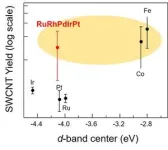A simple way to harvest more ‘blue energy’ from waves
2024-04-03
(Press-News.org) As any surfer will tell you, waves pack a powerful punch. Now, we are one step closer to capturing the energy behind the ocean’s constant ebb and flow with an improved “blue energy” harvesting device. Researchers report in ACS Energy Letters that simply repositioning the electrode — from the center of a see-sawing liquid-filled tube to the end where the water crashes with the most force — dramatically increased the amount of wave energy that could be harvested.
The tube-shaped wave-energy harvesting device improved upon by the researchers is called a liquid–solid triboelectric nanogenerator (TENG). The TENG converts mechanical energy into electricity as water sloshes back and forth against the inside of the tube. One reason these devices aren’t yet practical for large-scale applications is their low energy output. Guozhang Dai, Kai Yin, Junliang Yan and colleagues aimed to increase a liquid–solid TENG’s energy harvesting ability by optimizing the location of the energy-collecting electrode.
The researchers used 16-inch clear plastic tubes to create two TENGs. Inside the first device, they placed a copper foil electrode at the center of the tube — the usual location in conventional liquid–solid TENGs. For the new design, they inserted a copper foil electrode at one end of the tube. The researchers then filled the tubes a quarter of the way with water and sealed the ends. A wire connected the electrodes to an external circuit.
Placing both devices on a benchtop rocker moved water back and forth within the tubes and generated electrical currents by converting mechanical energy — the friction from water hitting or sliding against the electrodes — into electricity. Compared to the conventional design, the researchers found that the optimized design increased the device’s conversion of mechanical energy to electrical current 2.4 times. In another experiment, the optimized TENG blinked an array of 35 LEDs on and off as water entered the section of the tube covered by the electrode and then flowed away, respectively. The researchers say these demonstrations lay the foundation for larger scale blue-energy harvesting from ocean waves and show their device’s potential for other applications like wireless underwater signaling communications.
The authors acknowledge funding from the National Natural Science Foundation of China and the National Key Research and Development Program of China, and acknowledge computing resources from the High Performance Computing Center of Central South University.
The paper’s abstract will be available on April 3 at 8 a.m. Eastern time here: http://pubs.acs.org/doi/abs/10.1021/acsenergylett.4c00072
###
The American Chemical Society (ACS) is a nonprofit organization chartered by the U.S. Congress. ACS’ mission is to advance the broader chemistry enterprise and its practitioners for the benefit of Earth and all its people. The Society is a global leader in promoting excellence in science education and providing access to chemistry-related information and research through its multiple research solutions, peer-reviewed journals, scientific conferences, eBooks and weekly news periodical Chemical & Engineering News. ACS journals are among the most cited, most trusted and most read within the scientific literature; however, ACS itself does not conduct chemical research. As a leader in scientific information solutions, its CAS division partners with global innovators to accelerate breakthroughs by curating, connecting and analyzing the world’s scientific knowledge. ACS’ main offices are in Washington, D.C., and Columbus, Ohio.
To automatically receive news releases from the American Chemical Society, contact newsroom@acs.org.
Note: ACS does not conduct research, but publishes and publicizes peer-reviewed scientific studies.
Follow us: X, formerly Twitter | Facebook | LinkedIn | Instagram
END
ELSE PRESS RELEASES FROM THIS DATE:
2024-04-03
Choosing paint for your home brings a lot of options: What kind of paint, what type of finish and what color? Water-based paints have emerged as “greener” and less smelly than solvent-based options. And they are often advertised as containing little-to-no volatile organic compounds (VOCs). But, according to research published in ACS’ Environmental Science & Technology Letters, some of these paints do contain compounds that are considered VOCs, along with other chemicals of emerging concern.
Paint consists of four ingredients: pigments, binders, additives ...
2024-04-03
A fungus devastating frogs and toads on nearly every continent may have an Achilles heel. Scientists have discovered a virus that infects the fungus, and that could be engineered to save the amphibians.
The fungus, Batrachochytrium dendrobatidis or Bd, ravages the skin of frogs and toads, and eventually causes heart failure. To date it has contributed to the decline of over 500 amphibian species, and 90 possible extinctions including yellow-legged mountain frogs in the Sierras and the Panamanian golden frog.
A ...
2024-04-03
When we communicate with other people face-to-face, we do so by maintaining a certain physical distance from each other. This space surrounding our body while interacting is called the interpersonal space (IPS), and maintaining adequate IPS is crucial for better communication.
Many studies have investigated the psychological and physiological changes that occur based on the presence of another person in the IPS during face-to-face interactions. These studies are based on the avoidance behaviour that we experience when a stranger invades our IPS, which manifests in the form of increased heart rate and discomfort. However, ...
2024-04-03
California, a state known for its aggressive greenhouse gas reduction policies, is ironically the nation’s greatest emitter of one: sulfuryl fluoride.
As much as 17% of global emissions of this gas, a common pesticide for treating termites and other wood-infesting insects, stem from the United States. The majority of those emissions trace back to just a few counties in California, finds a new study led by Johns Hopkins University.
“When we finally mapped it out, the results were puzzling because the emissions were all coming from one place,” said co-author Scot ...
2024-04-03
Menlo Park, Calif. — After two decades of work, scientists and engineers at the Department of Energy's SLAC National Accelerator Laboratory and their collaborators are celebrating the completion of the Legacy Survey of Space and Time (LSST) Camera.
As the heart of the DOE- and National Science Foundation-funded Vera C. Rubin Observatory, the 3,200-megapixel camera will help researchers observe our universe in unprecedented detail. Over ten years, it will generate an enormous trove of data on the southern night sky that researchers will ...
2024-04-03
Scientists at the Institute of Pathophysiology of the University Medical Center Mainz made the first comprehensive analysis on how adults use tickling in connection with sexual activity. As part of their study, they surveyed 719 people with a so-called tickling fetish. The results of the study show that human sexuality encompasses a variety of forms of expression that need to be studied and understood in greater depth.
Most people laugh when they are tickled. But there are also individuals for whom tickling or being tickled triggers sexual arousal. This sexual preference is referred to as a tickle ...
2024-04-03
Research Highlights:
Asian American adults with more unfavorable factors related to income level, education, housing, access to health care and other social variables had a greater likelihood of having risk factors for cardiovascular disease in this study.
The relationship between social determinants of health and cardiovascular disease risk factors varied widely among some Asian American subgroups, based on the study’s findings.
Embargoed until 4 a.m. CT/5 a.m. ET Wed., April 3, 2024
DALLAS, April 3, 2024 — Having more unfavorable social determinants of health, such as being unemployed, uninsured or not having education beyond high school, ...
2024-04-03
Artificial Intelligence can be used to detect invasive Asian hornets and raise the alarm, new research shows.
University of Exeter researchers have developed VespAI, an automated system that attracts hornets to a monitoring station and captures standardised images using an overhead camera.
When an Asian hornet visits, VespAI can identify the species with almost perfect accuracy – allowing authorities to mount a rapid response.
Asian hornets (also known as yellow-legged hornets) have already invaded much of mainland Europe and parts of east Asia, and have recently been reported in the US states of Georgia and South Carolina.
The ...
2024-04-03
(Santa Barbara, Calif.) — A collaboration between research groups at the University of California, TU Dresden in Germany and Cedars-Sinai Guerin Children’s in Los Angeles has identified a mechanism by which embryonic cells organize themselves to send signals to surrounding cells, telling them where to go and what to do. While these signaling centers have been known to science for a while, how individual cells turn into organizers has been something of a mystery.
Until now. In a paper published in the journal Nature ...
2024-04-03
Tallinn, 3rd April 2024 - 10 AM CET – NAOS, the French founding company behind pioneering ecobiological skincare brands BIODERMA, Etat Pur, and Institut Esthederm, introduces its innovative new digital tool Skin Observer in collaboration with Haut.AI, a leader in AI applications for skincare and skin aging. The partnership merges cutting-edge AI technology with deep expertise in skin ecobiology.
Developed in collaboration with dermatologists, NAOS Skin Observer offers quick and precise skin analysis, recommending customized rituals adapted to individual skin types. The system adjusts routines based on user preferences, dynamic skin ...
LAST 30 PRESS RELEASES:
[Press-News.org] A simple way to harvest more ‘blue energy’ from waves









